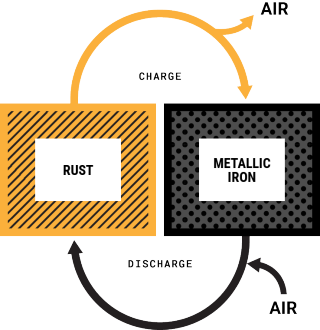Iron-air battery technology uses the principle of reversible rusting. The battery cells contain iron and air electrodes and are filled with a water-based, nonflammable electrolyte solution. While discharging, the battery absorbs oxygen from the air and converts iron metal to rust. While charging, the application of an electrical current converts the rust back to iron and the battery emits oxygen. The technology has lower costs compared to lithium-ion battery production.

Each individual battery module is about the size of a side-by-side washer/dryer set and contains a stack of approximately 50 one meter-tall cells. These battery modules are grouped together in environmentally protected enclosures. Hundreds of these enclosures are grouped together in modular megawatt-scale power blocks.
For scale, in its least dense configuration, a one megawatt system requires half an acre of land. Higher density configurations would achieve >3 MW/acre.
The 5 megawatt (MW) / 500 megawatt-hour iron-air battery storage project is the largest long-duration energy storage project to be built in California and the first in the state to use the lower-cost technology. It will be built at a Pacific Gas and Electric Company substation in Mendocino County and provide power to area residents. It is expected to begin operation by the end of 2025 to help support grid reliability and demonstrate solutions needed to meet the state’s climate and clean energy goals.
The award is one of three approved under the CEC’s Long-Duration Energy Storage program. The program invests in demonstration of non-lithium-ion technologies across the state to create a diverse portfolio of energy storage technologies.
As of August, California had 6,600 MW of battery storage in use throughout the state operating at the current industry standard of 4 to 6 hours of discharge. By year-end, the number is projected to increase to 8,600 MW. Longer-duration storage, from 8 to 100 hours, can help the state transition away from fossil fuels and strengthen grid reliability. The state estimates more than 48 gigawatts (GW) of battery storage and 4 GW of long-duration storage will be needed to meet the goal of 100% clean electricity by 2045.
The other awards approved under the Long-Duration Energy Storage Program are:
$31 million for a 60 MW renewable backup power microgrid in San Diego County.
$32 million for a 20 MW microgrid project in Tehama County.
The grants are two of the largest the state has ever awarded to benefit California Native American tribes.